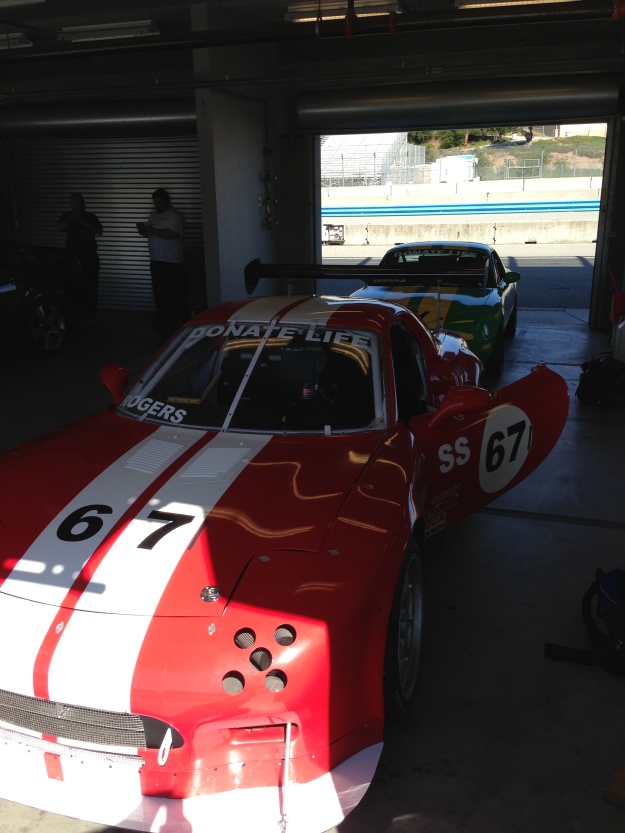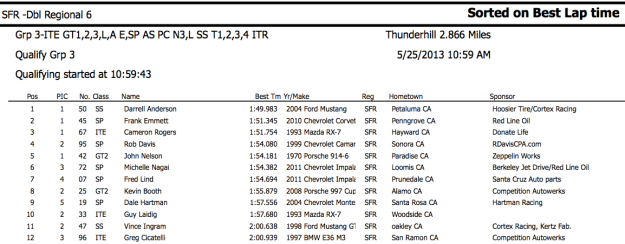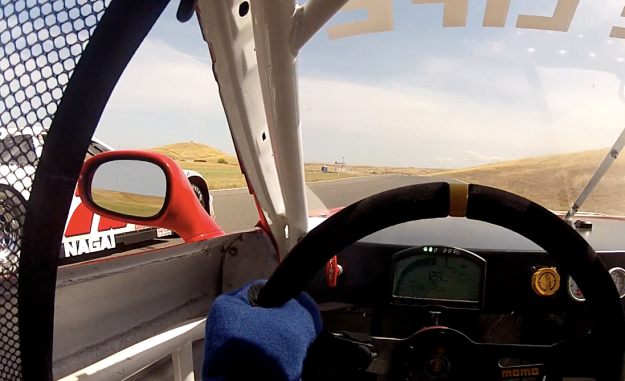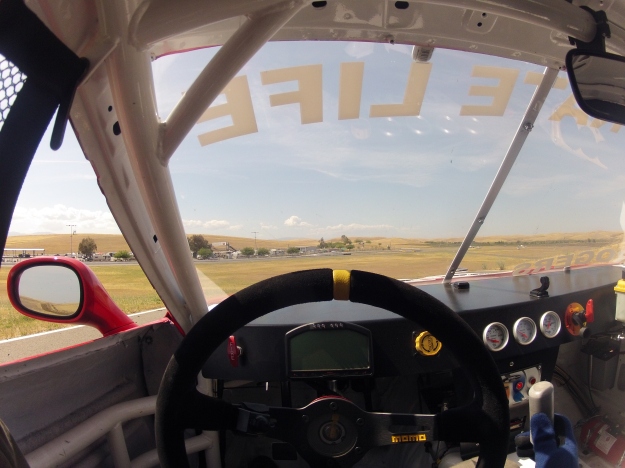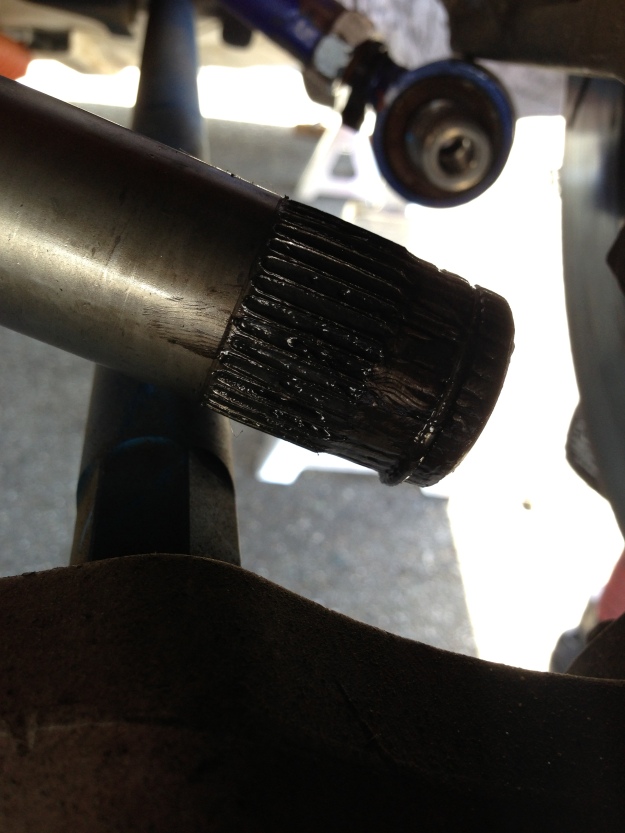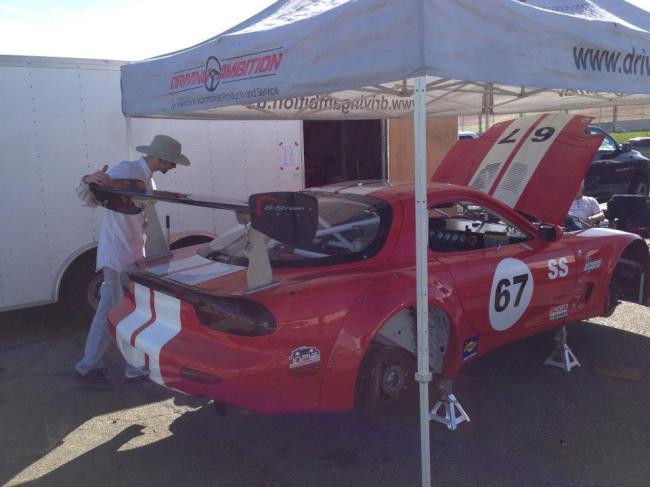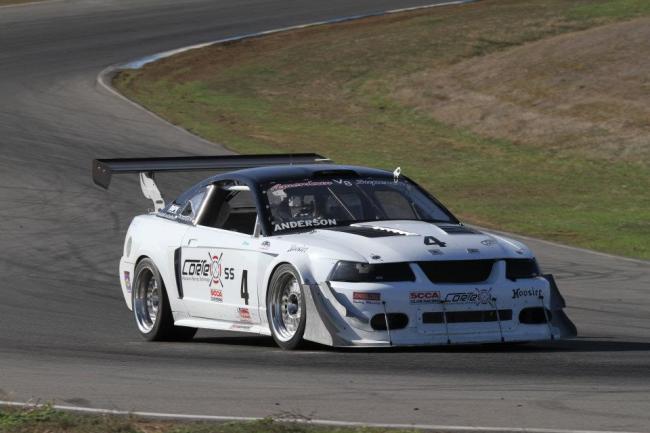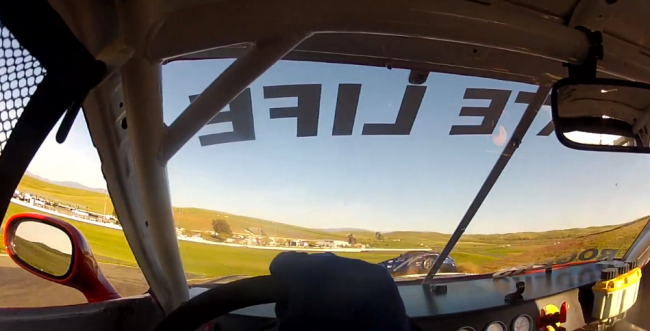You can test all you want, but that’s no guarantee that the car won’t break as soon as you start a race weekend.
That was the lesson I took away from last week. We went testing on Monday with CFRA, who had a rare 105 decibel day at Laguna Seca. At the race weekend at Laguna a few weeks prior, we had had a lot of setup and balance problems with the car, with lots of understeer and trouble getting traction off the corners. So we dedicated the CFRA day to putting a lot of laps on the car, and making sure the brakes were working and the balance of the car was feeling right.
We got a pit garage and shared it with Shan, who was feeling better driving the Miata after she’d had the wheels balanced. Phil changed anti-roll bar settings, ride height, rear springs, and rear wing angle, and we eventually wound up with a setup that felt like a good compromise between understeer in turns 3 and 4 and oversteer coming out of the corkscrew and turn 11. The car was reliable all day long and we booked a lot of laps.
I should have known the following race weekend was cursed from the very start. I picked up the trailer Friday night and trucked up to Willows. It was when filling up with gas in Williams that I realized that I had left the keys to the trailer on the bumper of the truck, and of course the keys had fallen off many miles ago. I talked to Phil and we resolved to get some bolt cutters from Walmart in the morning.
Saturday morning rolls around, and of course Walmart is out of bolt cutters. And the bolt cutter Phil got from a random hardware store isn’t up to the job of cutting off the locks. Luckily we were able to borrow Tom Wickersham’s angle grinder and Phil cut the locks of literally minutes before first practice started.
We just barely got out on track for practice, and we didn’t have enough time to put enough air in the tires. The car was sliding like it was ice on the cold under-inflated tires, but things were about to get a lot worse. Three laps in, the car suddenly veered right while turning into turn 6. I took a long detour through the grass. I thought I had a puncture on the front-right because the car drove very strangely on the way to the pits, having a lot of difficulty in left-hand corners.
When we got it up on jacks, Phil found that the front subframe had actually cracked a weld where it connected to the lower A-arm on the suspension. The car that had been fine for dozens of laps on Monday had a broken subframe on Saturday.
Amazingly, Phil was able to get it back into place and welded up at MCE racing for a mere $40. Even the alignment felt right afterwards. Great work Phil!
We also found that the rear tires were corded, which might have explained some of the lack of grip. So we swapped on a new set of Hoosier R6 tires, which were DOT legal unlike the R100 racing slicks we normally use. There was only three cars in V8 SS that weekend, so we switched classes to the ITE class that had five cars, but that necessitated running DOT tires.
With the car welded back together and fresh tires on for qualifying, we went out to break in the tires and set a lap time. Immediately the car felt great on the R6 rubber. DOT tires have a much wider temperature range where they have grip, as opposed to the more binary grip of racing slicks. With slicks, you either have no grip or tons of grip, and they are utterly silent and sudden when they lose traction. DOT tires, on the other hand, act a little more like street tires. They have less ultimate grip, but they slide progressively and make noise when they do so. This makes them much easier to drive on the limit than a racing slick.
A few warm-up laps into qualifying, and I had a nasty surprise in the form of a black-and-orange “meatball” flag being waved at me. I came into the hot pits, and they said the car was 3 decibels over the 103 decibel sound limit! This was the same exhaust system we had run at the 105 decibel Laguna day earlier in the week, and it sounded subjectively quieter than the original exhaust system that clocked just 95 decibel! So I drove into the pits, where Phil was ready with an exhaust “elbow” that directs the sound away from the sound meter. Despite the heat of the exhaust system Phil was able to install the elbow in seconds.
I drove back to the track with just a couple minutes left in qualifying to set a lap. This meant that I would have one lap to get the tires warm, and one flying lap to set a time, so the flying lap had to count. These kind of high-pressure situations can be incredibly fun and challenging for a driver, and you feel a bit like a F1 driver when you have just one lap to get the job done.
I set a 1:51.7 time on my one flying lap, good enough for third overall on the grid behind Darrell and Frank Emmett. This was about 2 seconds slower than my best time at Thunderhill, but we were expecting the R6 tires to be 1-2 seconds slower than the R100 slicks.
The first race was later that afternoon, and I was starting behind Darrell and Frank and ahead of Rob Davis and Michelle Nagai.
Coming up to the starter stand on the race start, I couldn’t see the starter at all over the looming Mustang of Darrell. So I went when everyone else started to go, and then I ran into the rev limiter at the top of second gear. Rob Davis and Michelle went flying by me into turn 1, and I was in fifth.
After a couple laps, I started catching Rob, whose “Lightning McQueen” Camaro is usually faster than me on the straights. But he was a bit off the pace this weekend, and I passed him on the inside of turn 10.
After that I started lining up Michelle, who had a great start and was setting some really nice lap times. She was clearly the class of the stock car field, even though she was having her own mechanical issues that day.
We had a good dice, and unlike at Laguna I was able to get around her this time. I passed her on the outside of the same corner that I’d gone by Rob, turn 10.
I could see Frank Emmett a ways up the road, which was a bit strange as his car is normally 3-4 seconds a lap faster than anything else in our field. Apparently this weekend he was having clutch trouble, slowing him down considerably. I caught him on the front straight, and passed him on the inside of turn 1.
The car was feeling nice and balanced, and so far the race was going pretty well. I was running second overall and I could see Darrell a ways up the road. I had started to gain on him, when coming out of turn 2 I heard a “pop” from the rear, and lost all drive. My race was over.
I pulled off onto the bypass around turn 5, and watched the rest of the race as a spectator. It was a great view from up there, as you could see most of turns 6, 7, 8, 11, 12, and 14/15.
When we got the car back to the pits after the race, we found that that right axle had seized up and stripped all the teeth on the axle shaft. The axle was custom, with inner teeth set up for Porsche gears and outer teeth compatible with the Mazda RX7 hubs, so the hopes of getting a replacement on a weekend in Willows CA were basically zilch. Our weekend was over.
Just before the race, Shannon and James had taped some dollar bills to “Candy” the RX7, and I guess the car decided that if she was going to be treated like a stripper, she’d live up to the name and strip the teeth on her axle.
With WWDC looming I’ll likely miss the next race at Laguna Seca, and we probably won’t get axles in time anyways. So next race will be 4th of July weekend at Sears Point in Sonoma. Should be good ol’ American fun!
Here’s the video of the race:

